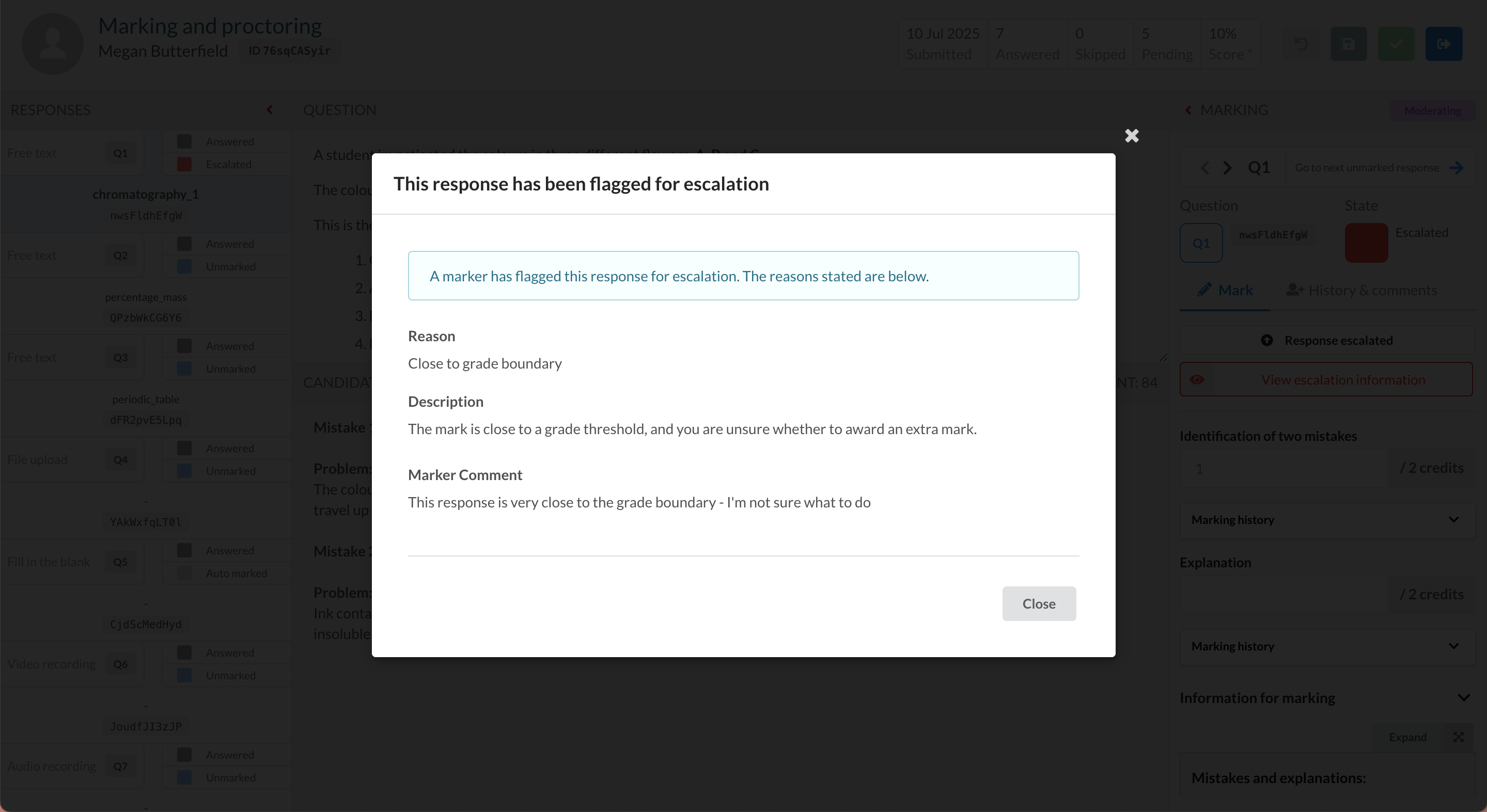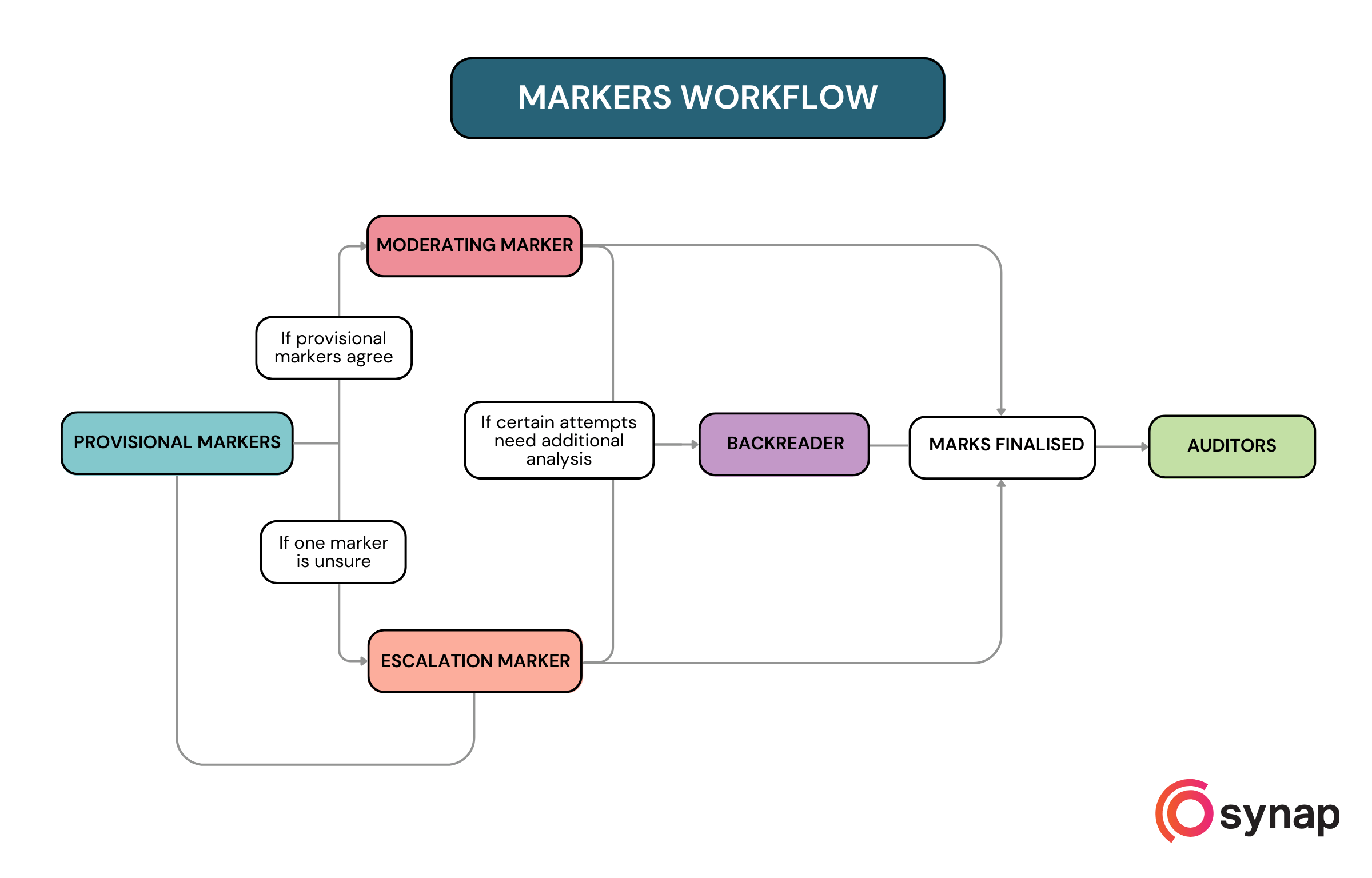Ready to experience Synap for yourself?
Key highlights
- Provisional markers apply rubrics independently, improving accuracy and reducing bias through multi-marker review.
- Moderating and escalation markers resolve disagreements and handle edge cases to ensure fair, consistent grading.
- Backreaders and auditors add final oversight, enabling full traceability and compliance in online exam marking.
Why marking roles matter for online exams
Institutions, exam boards, and professional bodies are adopting more robust, multi-layered marking workflows to ensure fairness, consistency, and transparency. Grading roles within the assessment process are evolving and each role plays a unique part in delivering high-quality outcomes.
In this blog, we explore the five key marker roles in online exam solutions - what they do, why they matter, and how they contribute to a reliable grading process.
The key marker roles explained
Provisional markers: The first line of grading
Provisional markers are the initial reviewers of candidate responses. Their role is to apply rubrics and assign scores, often working independently of each other in the first instance. Assigning multiple provisional markers per submission improves accuracy and helps reduce individual bias.
Key characteristics:
- Multiple provisional markers can mark the same attempt
- A minimum number of markers can be set per response (e.g. two per submission)
- Marking can be done in parallel or in a defined sequence (ordered marking)
- Their marks are compared to determine if they’re in agreement or disagreement based on a configurable threshold
When provisional scores are in alignment, the response may be considered final. If not, the response escalates to moderation. If you’re managing complex assessments, look for online exam grading tools that support multiple provisional markers, configurable agreement thresholds, and clear marking histories.

Moderating markers: Resolving disagreements
Moderating markers step in when there is a lack of consensus between provisional graders. Their role is to review all rubric areas, regardless of whether they were in conflict, and assign the final marks. Modern exam grading workflows let you define clear rules for when moderation is triggered, how disagreements are resolved, and who has authority to finalise marks.
Moderators:
- Can be auto-assigned based on rules (e.g. only in case of disagreement, or always)
- Have access to marking history and scoring variance to identify discrepancies
- Review each question and rubric independently
- Serve as the source of finalised marks, unless overridden later in the workflow (e.g by a backreader or auditor)
Moderating markers bring oversight, consistency, and experience to the grading process, ensuring that final grades are consistent with policy and expectations.
Escalation markers: Handling uncertainty
Sometimes a provisional marker may come across a response that is ambiguous, complex, or outside the standard marking rubric. Rather than forcing uncertain decisions, escalation markers provide an avenue for further review.
Escalation workflows typically include:
- Provisional markers selecting a reason for escalation (e.g, sensitive information)
- Escalation markers reviewing the response to determine the next steps
- Options to accept the escalation (and take over as moderator) or reject it (sending the attempt back into the original marking flow)
Escalation improves confidence in edge cases and reduces the burden on provisional markers to make high-stakes decisions in isolation.

Backreaders: Adding an extra layer of assurance
Backreading (or double-marking with override authority) is used when certain attempts need additional analysis, whether for quality assurance, training, or policy reasons.
Key features of backreading:
- Takes place after provisional and moderating inputs are completed
- Backreaders can provide their own marks and comments
- Their scores override all previous inputs, becoming the final decision
- Can be triggered by rules (e.g. a random 10% sample, low scores, or manual selection)
Backreading is especially useful in high-stakes or subjective assessments where additional oversight reduces risk of inaccurate marking and strengthens the credibility of outcomes.
Auditing: Post-finalisation review
Auditing adds a final layer of quality assurance after marking is complete. It supports examiner training and helps ensure consistent application of marking standards
Auditors may:
- Select a sample of completed responses for review
- Remark and comment without affecting the original final marks
- Use grade overrides if a formal correction is needed
The audit trail ensures compliance by providing full transparency and traceability of all actions throughout the marking workflow.

Smarter workflows, stronger outcomes
Defined roles like provisional, moderating, escalation, backreading, and auditing create a robust, multi-layered marking workflow. Together, they reduce bias, ensure consistency, support examiner development, and build trust in the results for high stakes exams. These roles are vital for maintaining the integrity and quality of grading.
Upgrade your marking workflow
Explore how Synap’s marker roles can enhance your marking processes with a tailored demo and a 14 day free trial.
Glossary
- Ordered marking A workflow where multiple markers assess a candidate's response in a predefined sequence, for example: one after the other.
- Parallel marking A process where multiple markers independently assess the same response at the same time, without seeing each other's input. This promotes impartiality and helps identify discrepancies or bias in scoring.
- Rubric marking A systematic approach to grading that uses a predefined set of criteria to guide how markers evaluate responses and assign marks across specific categories.
- Agreement / Disagreement threshold A pre-set margin of acceptable score variance between provisional markers. If the scores fall within this margin, the system considers the markers in "agreement". If the scores fall outside it, the response is flagged for moderation.
- Override authority The ability to replace all previous scores with a new final mark. This is typically granted to backreaders or auditors in the workflow.




